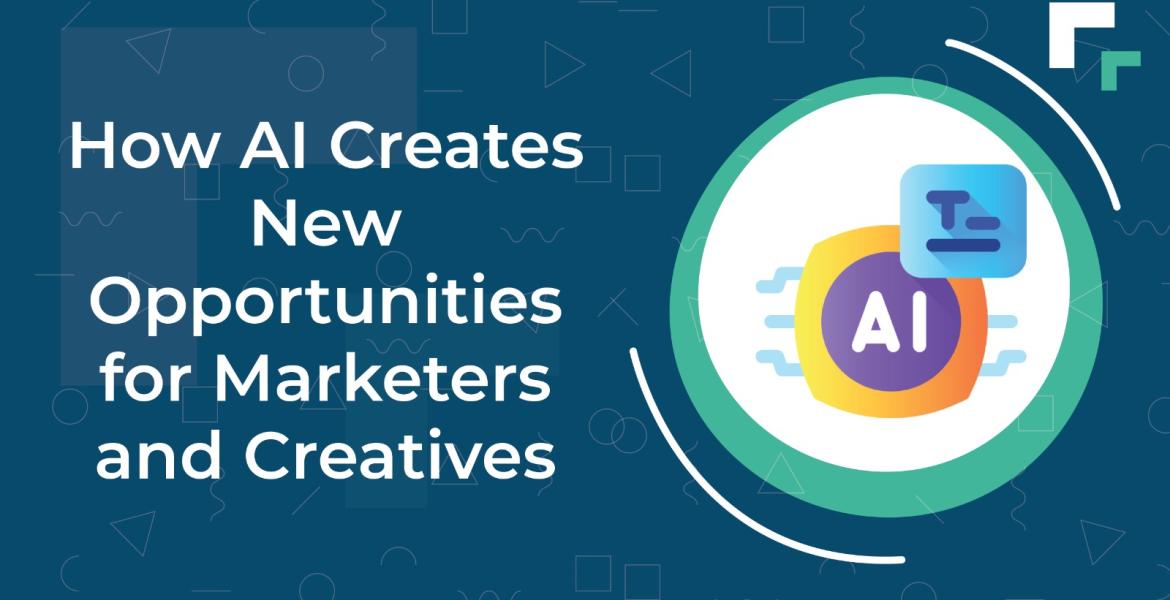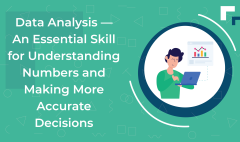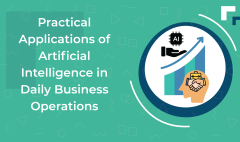How does artificial intelligence create new opportunities for marketers and creatives?

How does artificial intelligence create new opportunities for marketers and creatives?
Introduction
What is Artificial Intelligence?
Artificial Intelligence (AI) is, simply put, the ability of machines and software to simulate human intelligence such as learning from data, analyzing information, making decisions, and even showing creativity at times. Once considered science fiction, AI is now at the core of many of our daily tools from mobile apps to business and analytics platforms.
AI is not some super robot; it’s a smart network of algorithms that observes, learns, and executes faster than the human brain.
As AI continues to evolve, it has transformed various industries.
Digital marketing, creative content, graphic design, and even writing have become fertile grounds for AI adoption. Tasks that once required days of work can now be completed in minutes, thanks to automation and artificial intelligence.
Smarter Content Creation
AI Writing Tools and Text Enhancement
Marketers and creatives now have access to powerful tools that help them write content more efficiently and with higher quality. Tools like ChatGPT, Jasper, and Copy.ai can generate blog posts, social media content, and even email campaigns in seconds.
These tools don’t just write, they analyze the topic, maintain grammatical accuracy, and use the right keywords for SEO optimization. This not only saves time but also improves search rankings, which increases traffic and sales.
Even better, these tools learn from previous interactions. The more you use them, the more they adapt to your brand tone and style. That’s when your content starts to stand out you’re not just repeating what’s already out there, you’re creating something unique that truly reflects your voice and persuades your audience.
Creative Idea Generation Using AI
Every creative writer experiences “idea drought” staring at a blank screen with no clue where to begin. AI doesn’t just generate content, it can spark the idea itself. By analyzing market trends, popular topics, and audience behavior, AI can suggest innovative titles, unique angles, and insights into what your audience actually cares about.
It goes beyond words; it can generate illustrations, infographics, short video concepts, or even layout complete ad campaigns. AI transforms creativity from a slow personal process into a data-powered, collaborative experience.
Personalized Marketing and Intelligent User Experience
AI-Powered Product Recommendations
One of AI’s greatest achievements in marketing is smart personalization. When you visit an online store and see products that match your taste exactly, know that there’s an AI algorithm working behind the scenes. These algorithms analyze your behavior, the products you view or buy, how long you spend on each page… then show you recommendations based on your previous activity or similar customer patterns.
This personalized experience increases the chances of conversion, improves user satisfaction, and boosts brand loyalty. Instead of relying on generic ads, you can now target each campaign to a specific audience with extremely precise interests.
Behavioral Data Analysis
Marketing is no longer driven by intuition alone, it’s now a science built on real-time analysis of millions of data points. AI gathers and analyzes user behavior data: what they click, what they read, when they exit a page, how often they revisit a product.
All this data is used to craft more accurate and effective marketing campaigns. Marketers now create content based on numbers, not guesses guided by what AI predicts the user will do next.
Faster, More Professional Visual Design
AI-Based Graphic Design Tools
If you’re a designer or work in visual marketing, you’ve likely noticed how much easier design has become thanks to AI tools. Platforms like Canva AI, Adobe Firefly, and Designs.ai have completely changed the game. No need for advanced Photoshop skills or long hours of work all you need is a clear idea and a few clicks.
AI in design goes beyond logos or posters; it includes automatic color matching, font selection, visual layout suggestions, and even tips to improve the overall look. Best of all, you can generate multiple design versions instantly and choose the one with the best engagement.
As a creative, you now have an assistant that never sleeps. It inspires you, saves time, and opens new doors for experimentation without extra costs or wasted effort. AI hasn’t replaced the designer, it has empowered them with multiplied creativity.
Automated Photo and Video Editing
Short-form videos and reels are now the cornerstone of modern marketing, but producing them requires time and technical skills. That’s where AI tools like Runway ML, Pictory, Descript, and CapCut AI shine. They analyze videos, cut scenes, add captions, improve audio, adjust lighting all with a single click.
Imagine uploading a basic video and receiving a polished, professional version within minutes. It’s now possible to produce high-quality visual content without a studio or full editing team.
These tools can also remove backgrounds, apply filters, or even generate new faces or backgrounds. They’re not just editing tools, they’re creative platforms unlocking unlimited possibilities.
Marketing Automation and Performance Analytics
Email and Ad Automation
In the past, running marketing campaigns required a full team: a copywriter, data analyst, ad manager… Today, a single AI-powered tool can handle all of it. Platforms like HubSpot, Mailchimp, and ActiveCampaign use AI to create automated email campaigns, send them at the optimal time, and personalize the content based on each customer’s history with the brand.
You can also automate ads on Google or Facebook selecting the right audience, keywords, and timing based on algorithmic analysis.
AI doesn’t just speed up the process it improves performance, reduces costs, and delivers better results with fewer resources. It’s a true revolution in how marketing campaigns are executed.
Tracking Results and Improving ROI
After launching any campaign, the next step is analysis. Previously, this required manual Excel sheets and reports. Now, tools like Google Analytics AI, Tableau, and Looker Studio provide instant, interactive reports that analyze every click, interaction, and purchase.
You’ll know exactly what worked and what didn’t. AI suggests the exact adjustments needed to improve results and even offers predictive insights into future campaign performance.
In simple terms: AI gives you a “roadmap” to success based on accurate data, without manual effort. This means faster decisions, stronger performance, and smarter investments.
A Source of Creative Inspiration
AI in Writing Novels and Poetry
It may seem odd to link artificial intelligence with literary creativity, but reality now surpasses fiction. Tools like Sudowrite, ChatGPT, and NovelAI assist authors in crafting plots, developing characters, generating ideas for novels or short stories, and even composing poetry.
No, AI doesn’t steal a writer’s talent, it empowers them when inspiration is needed or to overcome writer’s block. By providing a prompt or opening line, AI completes the paragraph or suggests ways to develop the idea further.
Even poetry, a sensitive and emotional art form, now has AI collaborators that can produce rhythmic, harmonious lines, trained on the works of previous poets and extensive digital content.
AI-Generated Art and Music
Yes, AI can draw, compose music, and even innovate in ways humans had not imagined. Tools like DALL·E, MidJourney, AIVA, and Soundraw generate artistic visuals from words and musical compositions based on mood or requested rhythm.
Many artists use AI to create a “first draft,” then refine it manually. Others blend human creativity with AI-generated art to produce hybrid works that capture attention and inspire awe.
AI does not replace creativity; rather, it unlocks doors previously closed and gives every person a tool to express their inner artist, regardless of background or technical skills.
Interactive Models and Immersive User Experiences
AI Chatbots and Customer Experience
Today’s user experience goes beyond attractive web design or strong content. AI-powered chatbots like Intercom, Drift, ManyChat, and Tidio AI now deliver intelligent, real-time interaction. They respond to customer inquiries in seconds, understand questions, and provide tailored solutions sometimes without any human involvement. Bots can schedule appointments, recommend products, address FAQs, and handle complaints.
These bots learn from past conversations and improve over time, making the customer journey smoother and elevating the brand’s image to one of professionalism and intelligence.
AI with Virtual and Augmented Reality
VR (Virtual Reality) and AR (Augmented Reality) work hand in hand with AI to create astonishing experiences. For instance, when you use an AR-powered app that lets you preview products via camera, AI analyzes angles, dimensions, and visual data in real time.
In creative fields, AI enables interactive experiences that immerse users in stories or products. Whether designing a 3D marketing campaign or developing an interactive game, AI allows for personalization, enhancement, and user engagement analytics.
Influencer Marketing and Audience Performance Analysis
AI for Influencer Selection
The era of picking influencers randomly is over. AI tools like Heepsy, Upfluence, and HypeAuditor analyze data from thousands of influencers and recommend the most suitable ones for your campaign. They filter based on target audience, engagement rate, content type, and follower authenticity.
This analytical approach saves time and increases the likelihood of successful collaborations. Rather than choosing based solely on follower count, you now select influencers aligned with brand values and engaged audiences.
Performance Tracking and Campaign Optimization
Once the campaign is live, the real challenge begins: how do you measure success? AI comes in again algorithms analyzing audience reach, engagement, conversions, and other key metrics.
These smart tools tell you whether the campaign truly succeeded, which posts were most effective, and what content the audience resonated with. This transforms influencer collaborations into strategic partnerships built on data, not guesswork.
Opportunities for AI in Creative Education and Training
AI is no longer just a supporting technology, it’s fundamentally reshaping education. In creative training, educational content becomes dynamic, interactive, and adaptive to each learner.
AI enables personalized learning that considers individual pace, skill level, and interests, turning training into a responsive experience rather than a one size fits all lecture.
Creative trainers can deliver unique experiences: analyze learner style, provide instant feedback, generate real world scenarios, and foster practical skills not just theoretical knowledge.
This shift transforms learners from passive recipients into active creators engaging with content in ways that continuously evolve and adapt.
In short: AI doesn’t replace the instructor. It amplifies their impact, broadens their reach, and equips them with tools to cultivate a generation of learners who are intelligent, creative, and empowered.
AI–Powered Skill Development for Creatives and Marketers
Whether you’re a content writer, graphic designer, or digital marketer, your skills need constant evolution and AI offers that edge. AI-based educational tools analyze your work and offer tailored feedback on colors, composition, messaging, and design improvements.
This approach combines training with hands-on application, making skill development an ongoing, engaging journey not a burdensome task.
Ethical Challenges and Future Considerations
Data Protection and Privacy
With the rise of AI, it is essential to address ethical considerations, chiefly user privacy. When AI algorithms collect and analyze massive amounts of data, there is a substantial risk of misuse or data leaks.
Ordinary users may be unaware that their behavioral data is stored and used to tailor marketing campaigns or profile personalities. Thus, marketers and creators must utilize tools that adhere to international standards like GDPR and CCPA to ensure user privacy.
Data security extends beyond encryption and protection against breaches; it also demands transparency with users and giving them control over their data, which strengthens trust between the brand and the audience.
AI and Intellectual Property
Who owns a design generated by an AI tool: you or the tool? This is a complex legal question confronting digital-era creators. As AI can generate images, audio, and text, determining the “original author” becomes challenging.
Many countries are still reviewing IP laws concerning AI-generated content. Until these regulations are clear, users should review tool usage policies and confirm their legal rights over generated content.
The ethical challenge here goes beyond legal rights; it includes avoiding plagiarism and ensuring that training data for AI models come from properly licensed sources.
How to Begin Using AI in Your Creative Work
Tried-and-Tested Free Tools
If you’re new to AI, start with simple and free tools to explore its potential:
- ChatGPT – for idea and text generation
- Canva AI – for quick and professional visual designs
- Copy.ai – for marketing campaigns and email content
- Runway ML – for AI-powered video editing
- DALL·E – to generate images from text
- Pictory – to create short social media videos
- Jasper AI – for engaging marketing copy
Start with one or two tools you don’t have to learn everything at once. Experience is the best teacher, and you’ll learn how to integrate them into your workflow effectively over time.
Practical Tips for Integrating AI into Your Workday
- Launch a small project: Use AI for a marketing campaign or a test video.
- Always analyze results: Don’t rely solely on AI. Monitor performance and learn from it.
- Maintain your personal touch: AI supports creativity; it doesn’t replace the human touch. Add your voice to every project.
- Stay updated: Technology evolves quickly to keep up with new tools and updates.
- Collaborate with AI, don’t resist it: View AI as a colleague that helps you excel, not compete against you.
The Future: What Lies Ahead?
AI Innovations on the Horizon
AI is still in its early stages. The future promises astonishing developments: tools that understand emotions, visual intelligence that reacts to feelings, creative writing resembling human authors, and even real-time interactive 3D designs.
We also expect the rise of customizable AI companies and individuals can develop personal AI assistants that learn and evolve over time.
Generative AI is poised to drive the future of creativity, opening entirely new possibilities in cinema, gaming, education, and personal entertainment.
How to Prepare for These Changes
- Hone your skills: Learn AI tools and update your technical knowledge.
- Build a network: Join creative communities using AI.
- Invest in smart tools: Subscribe to platforms that enhance productivity.
- Never stop learning: Attend workshops, follow blogs, and test new tools regularly.
The future belongs to creators who adapt those who blend human creativity with AI to deliver remarkable results.
Conclusion
AI is not a threat to creativity; it’s a powerful ally for anyone striving to excel in marketing and creative content. Whether you’re a marketer, writer, designer, or entrepreneur, you now have tools that help you work faster, smarter, and better.
Embrace AI and remember, true creative genius still comes from the human behind the tool. Let AI add a spark to your creativity while your unique vision takes the lead.
Start today, and be among the first to shape tomorrow’s creative landscape.
FAQs
- Can AI replace marketers and creatives?
No, it enhances productivity and intelligence in decision-making. - Are there effective free AI tools?
Yes, tools like ChatGPT and Copy.ai offer free versions for starters. - What skills should one develop for the AI era?
Analytical thinking, creativity, data literacy, AI tool usage, and adaptability. - Is AI safe for marketing?
Yes if used with privacy standards and transparency. Choose reputable tools and review their policies. - How to integrate AI into small-scale projects?
Start with affordable or free tools and simple tasks like content creation or basic ad design.





